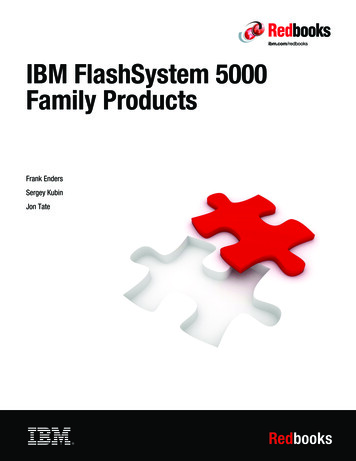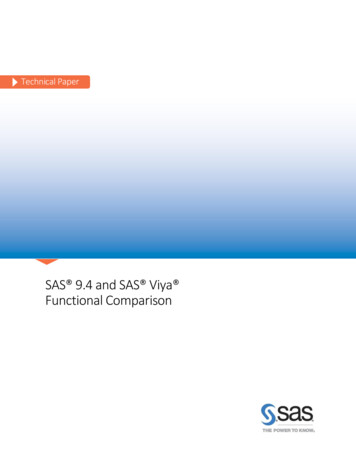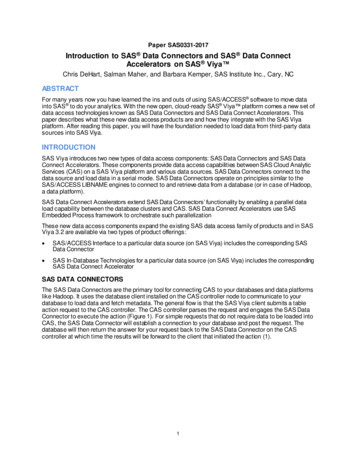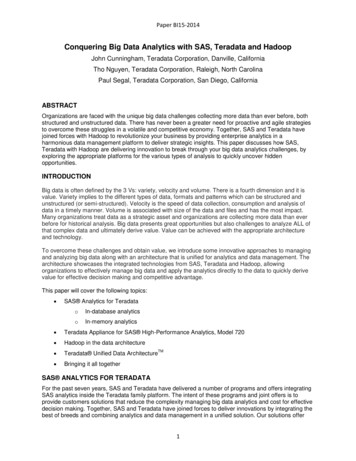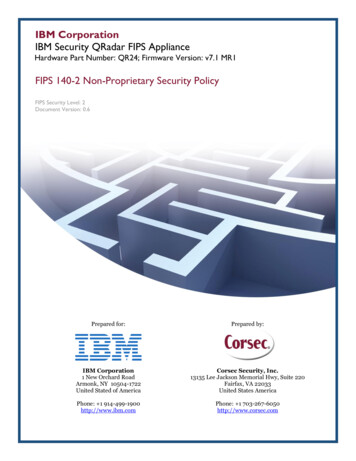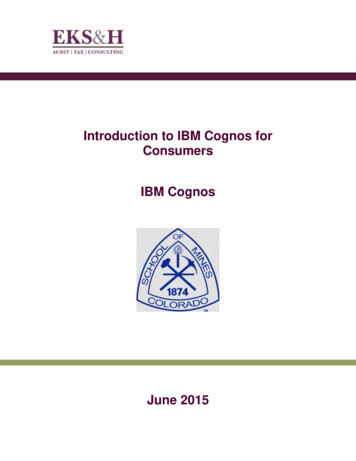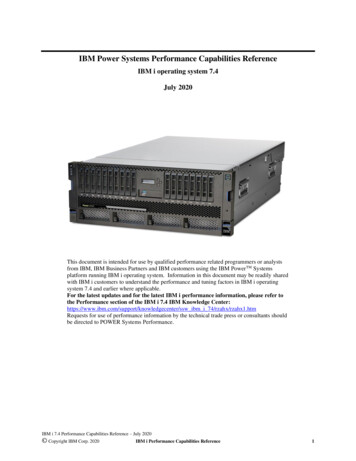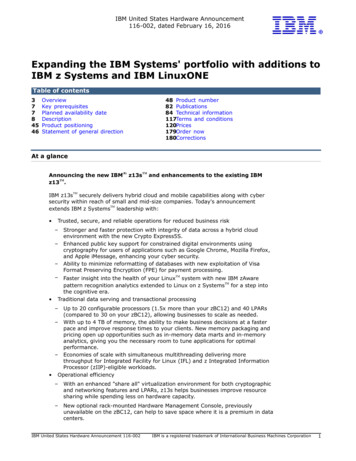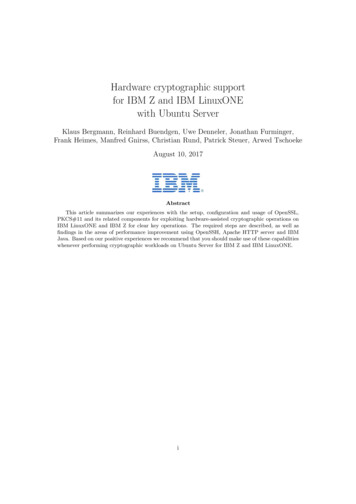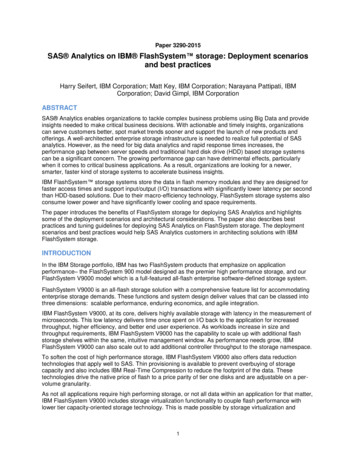
Transcription
Paper 3290-2015SAS Analytics on IBM FlashSystem storage: Deployment scenariosand best practicesHarry Seifert, IBM Corporation; Matt Key, IBM Corporation; Narayana Pattipati, IBMCorporation; David Gimpl, IBM CorporationABSTRACTSAS Analytics enables organizations to tackle complex business problems using Big Data and provideinsights needed to make critical business decisions. With actionable and timely insights, organizationscan serve customers better, spot market trends sooner and support the launch of new products andofferings. A well-architected enterprise storage infrastructure is needed to realize full potential of SASanalytics. However, as the need for big data analytics and rapid response times increases, theperformance gap between server speeds and traditional hard disk drive (HDD) based storage systemscan be a significant concern. The growing performance gap can have detrimental effects, particularlywhen it comes to critical business applications. As a result, organizations are looking for a newer,smarter, faster kind of storage systems to accelerate business insights.IBM FlashSystem storage systems store the data in flash memory modules and they are designed forfaster access times and support input/output (I/O) transactions with significantly lower latency per secondthan HDD-based solutions. Due to their macro-efficiency technology, FlashSystem storage systems alsoconsume lower power and have significantly lower cooling and space requirements.The paper introduces the benefits of FlashSystem storage for deploying SAS Analytics and highlightssome of the deployment scenarios and architectural considerations. The paper also describes bestpractices and tuning guidelines for deploying SAS Analytics on FlashSystem storage. The deploymentscenarios and best practices would help SAS Analytics customers in architecting solutions with IBMFlashSystem storage.INTRODUCTIONIn the IBM Storage portfolio, IBM has two FlashSystem products that emphasize on applicationperformance– the FlashSystem 900 model designed as the premier high performance storage, and ourFlashSystem V9000 model which is a full-featured all-flash enterprise software-defined storage system.FlashSystem V9000 is an all-flash storage solution with a comprehensive feature list for accommodatingenterprise storage demands. These functions and system design deliver values that can be classed intothree dimensions: scalable performance, enduring economics, and agile integration.IBM FlashSystem V9000, at its core, delivers highly available storage with latency in the measurement ofmicroseconds. This low latency delivers time once spent on I/O back to the application for increasedthroughput, higher efficiency, and better end user experience. As workloads increase in size andthroughput requirements, IBM FlashSystem V9000 has the capability to scale up with additional flashstorage shelves within the same, intuitive management window. As performance needs grow, IBMFlashSystem V9000 can also scale out to add additional controller throughput to the storage namespace.To soften the cost of high performance storage, IBM FlashSystem V9000 also offers data reductiontechnologies that apply well to SAS. Thin provisioning is available to prevent overbuying of storagecapacity and also includes IBM Real-Time Compression to reduce the footprint of the data. Thesetechnologies drive the native price of flash to a price parity of tier one disks and are adjustable on a pervolume granularity.As not all applications require high performing storage, or not all data within an application for that matter,IBM FlashSystem V9000 includes storage virtualization functionality to couple flash performance withlower tier capacity-oriented storage technology. This is made possible by storage virtualization and1
creates a consistency group for applications across flash and disk for copy services and disasterrecovery.For the pinnacle of tier-0 performance there is also IBM FlashSystem 900. This shelf of flash storagemaintains the high availability and serviceability of enterprise storage, but foregoes the data managementfunctions offered in IBM FlashSystem V9000 in favor of lowest available latency. This solution is mostadopted for critical point solutions.SAS ANALYTICS WORKLOAD CHARACTERISTICSThe SAS Analytics workloads are compute, IO and memory intensive and majority of the SAS Analyticsjobs are either compute intensive or IO intensive or both. The jobs predominantly perform large-blocksequential IO operations with a mix of read and write operations; read and write ratio is customerworkload specific and it varies from 55:45 to 80:20. In order to meet the IO needs of the SAS Analyticsjobs, the underlying infrastructure needs to support a minimum of 100 MBps per core IO throughput.SAS Scalable Performance Data Server (SPDS) IO characteristics are different from general SASAnalytics workloads. SAS SPDS IO is random with dynamic block-sizes, where block size can vary from8KB to 1MB. And SAS SPDS can run in parallel with traditional SAS Analytics jobs.SAS workload consists of two different set of file systems – SASDATA and SASWORK. While SASDATAstores persistent data which includes input, output files and SAS code, the SAS work area (SASWORKand SASUTIL file systems) stores temporary data that gets deleted at the end of each SAS job. In typicalcustomer deployments, SASDATA requires much more space for storing persistent data. It is veryimportant to layout and configure these file systems for optimal IO performance.SAS ANALYTICS DEPLOYMENT ON IBM FLASHSYSTEM STORAGEThe section describes some of the deployment scenarios for SAS Analytics on IBM FlashSystem storage.SAS Analytics customers can deploy their workloads in different ways to realize the benefits ofFlashSystems. Some of the deployment scenarios are: FlashSystem as a storage array for SAS workloads FlashSystem as part of hybrid-storage architecture for SAS workloads FlashSystem as a storage array for deploying shared file systems’ metadataFLASHSYSTEM AS A STORAGE ARRAY FOR ENTIRE SAS WORKLOADSIBM FlashSystem is a matured all-flash storage array that can be used to deploy entire SAS workload –SASDATA, SASWORK and SASUTIL. The FlashSystem with its macro-efficiency design, also consumelower power and have significantly lower cooling and space requirements, all while allowing serverprocessors to run SAS Analytics more efficiently.2
Figure 1. SAS Analytics deployment on FlashSystem arrayLatest offering from IBM FlashSystem family FlashSystem 900 supports up to 57 TB of usable capacity inRAID5. SAS analytics customers may have space and/or cooling constraints in their existing data center.IBM FlashSystem is a perfect choice for such environments which provides superior performance in asmall form factor (4U). Some of the FlashSystem offerings also support Real-Time Compression (RTC),which offers up to 5:1 data reduction and can deliver flash for less than the cost of a disk array at higherprice-performance than a disk-array.FLASHSYSTEM AS PART OF HYBRID-STORAGE ARCHITECTURE FOR SAS WORKLOADSWhen SAS Analytics customers have lot of data running into hundreds of TB or PB, it is not cost effectiveto deploy entire SAS workload on a FlashSystem. Deploying SAS Analytics on a hybrid storage modelwith a disk-based storage array (e.g. IBM XIV Storage System and IBM DS 8870) and FlashSystem (allflash storage) helps customers to get best of both worlds. This solution provides higher storage capacitywhile accelerating SAS Analytics at the same time. The persistent data of SAS workloads (SASDATA),which has larger physical space requirements can be deployed on disk-based storage system andtemporary SAS work area (SASWORK and SASUTIL) can be deployed on FlashSystem.3
Figure 2. SAS Analytics deployment on hybrid-storage involving FlashSystem and XIV Storage SystemFLASHSYSTEM AS A STORAGE ARRAY FOR DEPLOYING SHARED FILESYSTEM METADATAA shared file system, like IBM Spectrum Scale (formerly IBM GPFS ), is a required and integralcomponent of all SAS Grid Manager deployments, SAS Enterprise Business Intelligence deploymentswith load balanced servers on multiple systems, and other types of distributed SAS applications. Thespeed of the metadata access in a shared file system determines the overall IO performance of the SASAnalytics solutions. For example, IBM Spectrum Scale distributes metadata across the cluster nodes andit is very important to ensure metadata deployed on a faster storage sub system. IBM FlashSystem canbe used to deploy shared file system metadata for accelerating file access. When metadata is deployedon FlashSystem, the small block I/O operations of metadata no longer interfere with the large streamingaccesses for the data.Spectrum Scale supports multiple storage pools for a file system. A storage volume can contain data ormetadata or both. While creating network shared disk (NSD), designate the FlashSystem volumes tocontain metadata-only and XIV volumes to contain data-only. And designate FlashSystem volumes tosystem storage pool and XIV volumes to data storage pool, say appdata. Storage pool system is used formetadata by default. Spectrum Scale policies can be used to move data to appdata storage pool. Andwhile creating the file systems, use different file system block sizes for data and metadata, for optimal IOperformance.4
Figure 3. SAS Analytics shared file systems’ metadata deployment on IBM FlashSystemThe SAS analytics deployment on hybrid storage environment is described in detail in the followingsection.SAS ANALYTICS DEPLOYMENT ON HYBRID-STORAGE ENVIRONMENT WITHFLASHSYSTEMThis section describes deployment of SAS Analytics on IBM POWER8 processor-based servers andhybrid-storage environment involving IBM XIV Gen3 storage system and IBM FlashSystem 840.As described in the above sections, SAS workloads typically have two different set of file systems. WhileSASDATA stores persistent data which includes input and output files, the SAS work area (SASWORKand SASUTIL file systems) stores temporary data that gets deleted at the end of each SAS job. In typicalcustomer deployments, SASDATA requires much more space for storing input files and output files.Hence, it is beneficial to deploy SASDATA file system on XIV Storage System (which is disk basedstorage) and SAS work area on FlashSystem. The figure below describes the deployment in detail.IBM Power S822 (8284-22A) is a scale-out server with 2 sockets, 20 cores, and 256 GB memory. Theserver is configured with a Virtual I/O Server (VIOS) and five client logical partitions (LPARs). The VIOShelps in sharing the Fibre Channel (FC) adapters among the client LPARs by virtualizing the physical FCadapters using N Port ID Virtualization (NPIV). The test configuration uses a single VIOS, however, it isrecommended to use dual-VIOS in production deployments for high availability. IO traffic from XIV andFlashSystem is segregated using separate FC ports (physical as well as virtual) as shown in the aboveimage.One of the LPARs is used for testing SAS analytics. Logical unit numbers (LUNs) are created on the XIVand FlashSystem and are mapped to the LPARs. The SAS workload Spectrum Scale file systems arecreated on the mapped LUNs for running SAS analytics jobs. SASDATA file system is created with 16LUNs mapped from XIV Gen3 storage. 16 LUNs proved to be optimal for the workload used during the5
testing. 32 LUNs mapped for SASWORK and SASUTIL each from FlashSystem 840. For AIX clients, 32LUNs are recommended in the FlashSystem 840 implementation redbook.Figure 4. SAS Analytics deployment on hybrid-storage environment with FlashSystem and XIVCONFIGURATION AND TUNINGThis section describes the test environment, configuration and tuning recommendations for deployingSAS Analytics on IBM FlashSystem in a hybrid storage environment.HARDWAREPower S822 server configuration Model:Firmware version:Processor architecture:Clock speed:SMT:Cores:Memory used:Internal drives:FC connectivity:8284-22AFW810.02 (061)POWER84116 MHzOFF, 2, 4, 8 (SMT4 is default)20 (18 cores for the SAS Analytics LPAR and 2 cores for VIOS)256 GB (72 GB for the SAS Analytics LPAR and 8 GB for VIOS)Four 600 GB (used for booting VIOS and LPARs)Four quad-port 8Gb FC ports (16 ports) attached to the server;used 8 ports during the testing6
XIV configuration XIV machine type:2810Machine model:114System version:11.5.0.xDrives:180 SAS drives each with 2 TB capacity and 7200 rpm speedUsable capacity :161 TBModules:15Cache:DDR3 360 GBSSD cache:6 TBConnectivity:Six 8Gb dual-port Fibre Channel (FC) adapters (12 ports) connected tostorage area network (SAN)Stripe size:1 MB (default)SSD cache:Enabled (by default) for all volumes used in workloadFlashSystem 840 configuration Canisters: 2Flash Modules: 12 x 3.7 TBFlash Type: Toshiba 24nm eMLC 512 GbTotal Capacity: 37.5 TB (RAID5) (11 member drives and 1 spare)Code Level (FW): 1.1.3.2FC Ports connected: 8 x 8Gb FC ports (4 ports attached to each canister) are connectedfrom SAN to FlashSystem 840A single RAID5 array is created out of the 12 flash modules with one of the modules as a spareand stripe size used is 4KB.Storage area network (SAN) configuration Two FC switches - IBM System Storage SAN24B-4 Express (24 ports) and IBM System StorageSAN40B-4 (40 ports); both support NPIVSixteen 8Gb dual-port FC ports connected from Power S222 server to the SAN fabric; Eight portsconnected to the first switch and eight more ports connected to the second switchTwelve 8Gb FC ports connected from SAN Switches to XIV Gen3Switch zoning is performed on the SAN switches such that each logical disk assigned from XIV tothe LPAR has 12 or 24 paths.SOFTWARE SAS 9.4 M1 64-bit softwareIBM AIX 7100-03-03-1415VIOS 2.2.3.3IBM PowerVM Enterprise EditionIBM Spectrum Scale (formerly GPFS) 3.5.0.21TUNING RECOMMENDATIONSThe following list describes the tuning guidelines for SAS workloads to perform optimally on POWER8processor-based servers with the AIX 7.1 operating system on hybrid-storage environment with XIV Gen3and FlashSystem 840.7
AIX tuningFollow the SAS on Power / AIX Tuning Guides ex/WP101529.XIV Storage System- No specific tuning required on XIV Storage Systems. It works using the defaultenvironment.- XIV by default uses wide stripe and stripes data across all the available disks. The XIVGen3 system used in testing has 180 disks.- XIV uses 1 MB as the stripe size, by default. Spectrum Scale tuningpagepool 8G (default 1G)seqDiscardThreshhold 1G (default 1MB)maxMBpS 12000 (default 2048)prefetchPct 40 (default 20)maxFilesToCache 20000 (default 4000)scatterBuffers no (default yes)stealFromDoneList no (default yes) FC Adapter and logical disk tuningSince the IO paths and FC ports are different for XIV and IO traffic, it is recommended to tunethem differently to optimize the overall IO performance. The queue depth, max transfer sizeneeds to be tuned for XIV and FlashSystem adapters at both the client LPAR and VIOS. Refer toSAS business analytics deployment on IBM POWER8 processor-based systems white paper ex/WP102515. FlashSystem specific tuning for LUNs.- 32 LUNs per file system- Sector / block size while creating LUN: 512 (default)- Auto Contingent Allegiance (ACA) support: yes (default)DEPLOYMENT BEST PRACTICESThe best practices deployed in this section are for a deployment with hybrid-storage involving IBMFlashSystem 840 and IBM XIV Gen3. However, the recommendations can be applied to a scenariowhere entire SAS workload is deployed on an IBM FlashSystem.Spectrum Scale (formerly GPFS) file system layout and configurationSASDATA file system is created out of LUNs mapped from XIV storage and SASWORK and SASUTIL filesystems are created out of the LUNs mapped from FlashSystem 840. The sizes of the volumes can varydepending on the total size of the file systems. SASDATA (on XIV Gen3):- 4 TB total size with 16 LUNs of 256 GB each- file system block size: 1 MB- file system block allocation type: Cluster (default is scatter)SASWORK (on FlashSystem 840):8
- 4 TB total size with 32 LUNs of 172 GB each- file system block size: 256 KB / 512 KB- file system block allocation type: Scatter (default) SASUTIL (on FlashSystem 840):- 1.6 TB total size with 24 LUNs of 50 GB each- file system block size: 256 KB / 512 KB- file system block allocation type: Scatter (default)Please note that during the testing in lab environment, scatter file allocation type proved to be optimalwhen using FlashSystem. Whereas cluster block allocation type proved to be optimal while using XIVGen3 storage. The allocation type need to be chosen based on the number of LUNs and cluster size inproduction environments.Segregate IO trafficThe LPAR used for testing has 16 virtual client FC ports that are mapped to 16 virtual server FC ports atVIOS. The virtual server FC ports in turn are mapped to 16 physical FC ports that are assigned to theVIOS from HMC. IO traffic is segregated at switches by optimal zoning. The zoning details are depicted inthe below figures. The IO traffic segregation helps in tuning FC adapters differently to suite the nature andsize of the IO.Figure 5. Recommended zoning details for XIV IO traffic in hybrid-storage environment9
Figure 6. Recommended zoning details for FlashSystem IO traffic in hybrid-storage environmentSAS ANALYTICS PERFORMANCE ON FLASHSYSTEMSAS WORKLOAD PERFORMANCE IN HYBRID-STORAGE ENVIRONMENTTo understand SAS business analytics performance on IBM Power S822 server and hybrid-storageenvironment with XIV Gen3 and FlashSystem 840, SAS mixed analytics 20-session workload was run ona single LPAR. The 20-session workload was the appropriate sized workload given the compute and I/Odemands of the workload on the Power S822 server with two sockets and 20 cores. The Power S822server with 20 cores and 256 GB memory can also support a more intensive 30-session workload;however, lower response times are expected compared to a 20-session workload.20-SESSION WORKLOAD PERFORMANCEHere is the configuration used for the workload: LPAR is configured with 16 cores in dedicated mode with SMT4; 64 GB memoryVIOS is configured with 2 cores in dedicated mode and SMT4; 8 GB memoryUsed 512KB block size for SASWORK and SASUTIL GPFS file systems that are deployed onFlashSystem (512KB block size proved optimal for GPFS file systems on FlashSystem 840).The workload was run with no other competing activity on the server or storage systems.Performance summary of the workload: Workload response time is 1134 minutes, user time is 781 minutes, and system time is41minutes.10
Combined (at FlashSystem and XIV) peak I/O throughput is 5.0 GBps and sustained I/Othroughput is 3.25 GBps, which translates to 200 MBps per core sustained I/O throughput.At XIV, peak latency is 3 ms and average latency is 1 ms (for SASDATA file system); AtFlashSystem 840, peak latency is 4 ms and average latency is 2 ms (for SASWORK andSASUTIL file systems).Average processor usage (user sys) is 56% and wait is 6%At host, average disk service time is 3.5 ms and the peak disk service time is 7 msTotal data transferred during the workload is 11 TB (9 TB read and 2 TB write)Note: POWER8 Processor Utilization Resource Register (PURR) factors were applied on the CPU (userand system) times mentioned above. Refer to SAS business analytics deployment on IBM POWER8processor-based systems paper at /WP102515for more details on PURR and how to apply themThe graphs below depict the IO performance at XIV and Flash for the 20-session workload in hybridstorage environment.Figure 7: Mixed Analytics 20-session IO performance at FlashSystem for SASWORK & SASUTIL11
Figure 8: Mixed Analytics 20-session IO performance at XIV for SASDATAThe workload used during the testing is large-block sequent
IBM Power S822 (8284-22A) is a scale-out server with 2 sockets, 20 cores, and 256 GB memory. The server is configured with a Virtual I/O Server (VIOS) and five client logical partitions (LPARs). The VIOS helps in sharing the Fibre Channel (FC) adapte
